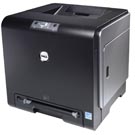Ink or laser: Look at your needs when buying a printer
Berlin (dpa) -  Buying a new printer can be a disorienting experience
Buying a new printer can be a disorienting experience
for many consumers. The choices can be overwhelming: there are inkjet,
laser or combined units, each with differing technical benchmarks and a
wide range prices within each product group.
Yet you can make small work of big decisions by focusing on your needs, analysts say.
"Your individual requirements should be decisive when purchasing a
new printer," advises Henning Withoeft from the German consumer testing
organization Stiftung Warentest in Berlin. People who print out a lot
of material make different demands on the machine than someone who only
uses it occasionally.
"Inkjet printers are suitable for private users with normal to low
printing volumes in both black and white and colour," says Tim Gerber
from Hanover-based computer magazine c't. Inkjets are actually the most
versatile devices. "Most can print anything from a CD cover to photo
paper - an extreme range of media - in colour and black and white,"
Gerber says. Additional benefits include the cheap purchase price, as
well as the small size and low weight.
The downsides are print speed and price per page - in both cases
poorer than their laser printer cousins. "The consumables like ink
cartridges and print heads are also often very expensive for ink jet
printers," Withoeft says. That's why he reminds potential buyers to
check not only the cost of the device but the accessories as well.
In general, the prices of various printer inks have become
standardised. Only a few years ago, however, the differences between
the cheapest and most expensive ink providers were enormous. "The range
just isn't as big any more," Withoeft explains.
One way to save money is to buy cartridges with integrated print
heads. "Switching the cartridge also brings a new print head at the
same time. If the ink dries up after several weeks of disuse, you then
don't have to buy a new one," says Withoeft. Laser printers are
primarily of value for volume printing, such as for office use. "They
generally have a large paper slot and are designed for high printing
volumes," explains Tim Gerber from c't.
The cost of consumables are relatively low and the printouts are
generally sharper and more durable. The devices are usually quieter and
quicker, too.
"There's also no ink to dry out, and there's no need to clear or
replace the print head," says Gerber. Instead of cartridge changes, the
entire toner unit is swapped out once a certain print volume has been
achieved.
The downside when compared to inkjet printers is the high purchase
price, the bigger dimensions of the devices, and the heavier weight.
"Unless you buy an expensive colour laser printer, then you'll also
have to go without colour prints," says Gerber. In some cases, it may
appear that the purchase price for laser printers has sunk
significantly.
"Yet I'd recommend against buying low-end devices from discount
outlets," says Gerber. "They are frequently of very poor quality."
Another option is the use of so-called combination devices. They
combine an inkjet printer, scanner and copier in one. These
multifunction devices are usually cheaper than purchasing comparable
individual devices and are particularly valuable to users with
restricted space and normal print loads.
"The problem comes when one of the functions breaks. The remaining
functions are then also frequently inoperable as well," Withoeft notes.
Energy consumption is another factor to consider. The choice of
device type makes a big difference here, Stiftung Warentest claims.
According to the organisation's Test magazine, inkjet printers require
less electricity than laser printers both during operation and while in
stand-by mode.
The magazine compared seven inkjets, five black-and-white laser
printers and four colour laser printers to see how they rated in terms
of printing properties, costs, environmental friendliness, versatility,
and ease of use.
The more functions a printer offers, the more crucial that it be
easy to use. "We found no significant problems in terms of user
friendliness in the mid-line price segment," Withoeft says.
One thing to remember is that the new printer should be set up to
work with the computer according to the manufacturer's guidelines.
"The basic functions should be clear without having to read thick
handbooks, and the printer should be able to be commissioned in just a
few steps," says Smycek from the Consumer Central for Lower Saxony,
Germany. This is particularly important for combination units. "Many
users are scared off by thick handbooks and operating instructions on
the CD ROM. That's the first thing to get tossed into the corner,"
Withoeft says. (dpa)